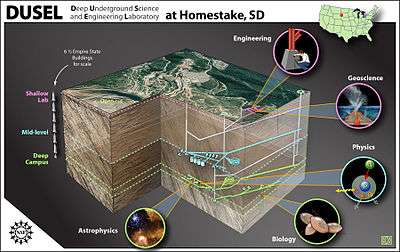Sanford Underground Research Facility

The Sanford Underground Research Facility (SURF), formerly Sanford Underground Laboratory at Homestake (or Sanford Lab) is an underground laboratory near Lead, South Dakota, which houses multiple physics experiments in areas such as dark matter and neutrino research. It was initially planned to be part of the United States Department of Energy's Deep Underground Science and Engineering Laboratory (DUSEL) project.
History
The Homestake mine was a deep underground gold mine founded during the in 1876 during the Black Hills Gold Rush. As the largest and deepest gold mine in North America, Homestake produced more gold than any other mine in the world during its peak years. Over its 125-year lifetime ending in 2001, the mine produced 39.8 million ounces of gold and 9 million ounces of silver.
In the late 1960s, the mine hosted Homestake experiment. The operation, also known as the Davis experiment, allowed Raymond Davis, Jr.'s to measure the flux of solar neutrinos directly. The measurements' discrepancy with the flux predicted from the Sun's luminosity led to Davis's development of the solar neutrino problem. The Homestake experiment publicized the mine as a resource among scientific communities.
DUSEL
The Deep Underground Science and Engineering Laboratory, or DUSEL, was a major project under consideration by the research wings of the United States Department of Energy (DOE). DUSEL was planned to be a series of large laboratories, caverns, and cleanrooms serving the field of underground science. The main impetus for DUSEL was the study of extremely rare nuclear physics processes, like neutrino scattering, dark matter interactions, and neutrinoless double beta decay, which can only be studied in the absence of cosmic rays. (Cosmic ray muons on the Earth's surface cause backgrounds in these types of detectors, but the particles cannot penetrate great depths in rock.) Easy access to these great depths will open new frontiers in geomicrobiology, geosciences, and mining engineering, making DUSEL a multidisciplinary facility.
Various proposals for an American underground science facility have existed for at least a decade. Eight teams submitted proposals in 2005, including both existing mines (which need only be retrofitted and enlarged) and "green sites" from which a new facility could be excavated. Of these eight, via various downselections, the NSF gave R&D grants to two proposals, Homestake Mine (South Dakota) and the Henderson molybdenum mine in Colorado. In July 2007 the NSF gave its approval to Homestake.[1]
If completed as initially planned, Homestake would have been the deepest underground science facility in the world, 8,000 feet (2,400 m) below ground (7200 meters of water equivalent, for cosmic-ray shielding purposes), deeper than the current record holder, the China Jinping Underground Laboratory 7,900 feet (2,400 m) below (6720 mwe). The next-deepest US facilities are the Waste Isolation Pilot Plant at 2300 mwe and Soudan mine at 2200 mwe.
Gaining access to that depth took some time, since as of 10 August 2009 the mine was flooded to the 4,992-foot (1,522 m) depth[2] and needed to be pumped dry and rusted equipment repaired. Plans were to construct an interim laboratory, at the 4,850-foot (1,480 m) level.[3] This "Sanford Underground Laboratory at Homestake", currently funded by T. Denny Sanford ($70 million) and the state of South Dakota ($35 million) was to support a National Science Foundation grant application for the full DUSEL (est. $550 million) in 2011.[4]
In 2008, the Rapid City Public Library created a DUSEL wiki[5] that collects news articles, photos, and information pertaining to the experiments that took place in Homestake Mine. It also included a list of other underground science facilities and a forum for community discussion.
In late 2010, the oversight board of the National Science Foundation dropped out of the project leaving the future of DUSEL in doubt. The National Science Board rejected requests from DUSEL’s designers for more money after spending the $19 million allocated. Additionally, the board did not like its proposed role in DUSEL that would have made the foundation part of a stewardship program to run it.[6]
Sanford Lab
In 2011, the Department of Energy agreed to fund ongoing research at the Sanford Lab, with the South Dakota Science and Technology Authority operating the lab through the Lawrence Berkeley National Laboratory. The first two major experiments sited at the lab were the Large Underground Xenon experiment (LUX) for dark matter research, and MAJORANA, which searches for the rare phenomenon of neutrinoless double beta decay. The installation of the Compact Accelerator System for Performing Astrophysical Research (CASPAR) experiment began in August 2015 with the goal of beginning calibration testing by January 2016.[7] The DOE has selected Sanford Lab as the far-detector site for the Deep Underground Neutrino Experiment (DUNE).[8]
Experiments
Experiments at the Sanford Lab include:
- Large Underground Xenon experiment (LUX): Located on the Davis campus, initial run completed in 2013
- LZ experiment, a successor to the LUX and ZEPLIN-III experiments.
- MAJORANA
- Deep Underground Gravity Laboratory (DUGL), testing SURF's suitability for a gravity-wave detector.
- GEOX , a network of rock mechanics sensors
- Compact Accelerator System for Performing Astrophysical Research (CASPAR) formerly DIANA
Planned experiments include:
- Deep Underground Neutrino Experiment (DUNE) (formerly Long Baseline Neutrino Experiment (LBNE))
See also
References
- ↑ "07-075: Team Selected for the Proposed Design of the Deep Underground Science and Engineering Laboratory" (Press release). NSF. 2007-07-10. Retrieved 2007-08-28.
- ↑ "Weekly Water-Level Reports". South Dakota Science and Technology Authority. 2009-02-02. Retrieved 2009-02-06.
- ↑ Bill Harlan (2006-11-28). "Mine Water Rises". Rapid City Journal. Archived from the original on 2007-09-29. Retrieved 2007-08-28.
- ↑ "Welcome to deep science". South Dakota Science and Technology Authority. Retrieved 2008-04-13.
- ↑ "Welcome to Rapid City Public Library's Sanford Lab Wiki!". Retrieved 2011-10-11.
- ↑ "U.S. Science Community Suffers Setbacks Despite Obama's Push for More Investing". Fox News. 2011-07-16.
- ↑ "CASPAR moves in". Sanford Lab. Retrieved 2015-10-24.
- ↑ "DUNE and LBNF on the move". Sanford Lab. Retrieved 2015-10-24.
External links
- Sanford Underground Research Facility Home page
Coordinates: 44°21′07″N 103°45′04″W / 44.352°N 103.751°W